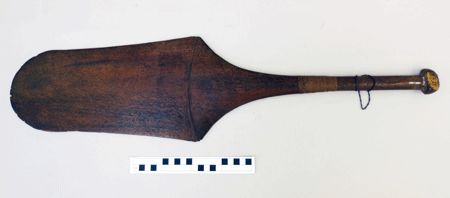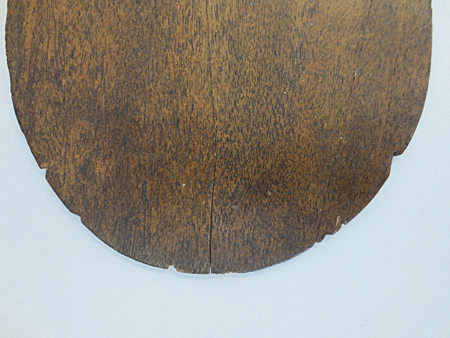This is another post written by Emma Schmitt, the Conserving 'Curiosities' project summer intern.
 |
| 1886.1.1367 Paddle, Tonga |
This carved wooden paddle from Tonga was listed by George
Forster in 'The Catalogue of Curisoities Given to Oxford' as No 81 “A spatula of wood to mix up their paste of breadfruit with”.
The
form and shape of this object suggests that the object may have had a
prior role as a dance paddle, used by men of high rank in a dance called
me’etu’upaki (Kaeppler 1978). This term means ‘dance’ (me’e) ‘standing’ (tu’u) ‘with paddles’ (paki).
The Forsters did not see this dance being preformed and thus probably
had no knowledge of it. Cook, however, saw and described the dance
during his third voyage:
‘It was a kind of dance, performed by men and youths of
the first rank; ... Any number may perform it, there were in this one
hundred and five, each having in his hand an Instrument shaped something
like a paddle of 2.5 feet in length, with a small handle and thin blade
so that they were very light and the most of them neatly made. With
these Instruments, they made many and various flourishes each of which
was attended with a different attitude of the body and some different
movement or another They at first ranged themselves in three lines, and
by different movements and motions each man changed his station in such a
manner that those who were in the rear came in front. Nor did they
remain long in the same form, but these changes were made by pretty
quick movements; they at one time extended themselves in one line then
formed into a semicircle and lastly into two square Columns, while this
last was performing, one of them came and danced a harlequin dance
before me with which the whole ended.’
 |
| Broken handle of paddle lashed together with plaited coconut fibre |
The Pitt Rivers’ paddle has been carved from native hardwood, and it is deceptively lightweight. It was damaged at some point, the handle breaking away from the blade completely. It was mended using braided coconut fiber to secularly wrap the break and hold the two pieces in place. Chips to the wooden blade are on the edge of the blade, possibly indicating a long period of use.
 |
| Tip of paddle, showing damage |
This pattern of damage indicates that the paddle may not
have ended its time on Tonga as the prestige item it was first meant to
be. How can an object move
from a prestige object used by elite men to a utensil of daily use? In
simplest terms, the very fact that this was a prestige object is what
saved it for repurposing. The
time, energy and material that went into creating such and object meant
that, if it could be repaired it should not be thrown away. It
was probably no longer appropriate to be used during dances, but it
could be used for another task, in this case the preparation of
breadfruit paste. The spatula’s role in the preparation of breadfruit paste is difficult to discern. Methods of paste production have been documented, though not thoroughly, and tend to vary between the islands.
The breadfruit tree grows throughout the south pacific and
was a main source of food for the population of the islands Cook
visited; it was also one of the products he traded for to keep the crew
of the ships provisioned. The
fruit was out of season for some portion of the year making
preservation of this staple imperative for the island communities. And
earlier post here provides Joseph Banks’ description of the process as
well as his opinions on taste:
Banks’ opinion aside, the description he provides is
helpful, but does not give any indication as to what a spatula may have
been used for. More modern discussions of the fermentation of breadfruit provide a fuller description of the later stages of the process.
After the breadfruit has been buried, the period of time the fruit remains in the pits is variable, from a few months to years. In
fact in the 1980’s a pit was uncovered that was believed to be over 300
years old and the paste inside was deemed “still in edible condition”
(Pollan, 2013). It must be said that this was a rare find and the definition of “edible condition” may very between people, however, the general thought is that breadfruit paste gets better with age.
Overall, the management of these pits differs. In some cases fresh fruit may be added to the pits, or old paste mixed with new. In other places, paste from year to year was kept completely separate (Pollock 1984).
The paste, when eaten, goes through a preparatory process that involves mixing it with water, kneading, and baking. Descriptions of the fermented paste indicate that is dry and possibly hard in its fermented form.
No direct reference is made to where in the process a
spatula may be used, however, there are many times with both the
fermentation process and the food preparation that such a utensil may
have been put to use. These
include, but are not limited to, removing the paste from the pits if old
and new paste were to be layered together or if paste was needed for
food. A spatula may have also been useful while mixing the paste with water before the kneading process.
Objects like this are incredibly important because it makes us think differently in terms of use and reuse. Had
the Forsters not recorded what they saw as the use of the paddle we
would be seeing it as a completely different object, not related to food
preparation at all, but to the male members of society and the role of
dance on the island; completely different cultural practices that wind
up coming together in this simple object.
Beaglehole, John Cawte, The Journals of Captain James Cook on his Voyages of Discovery The Voyage of the Resolution and Discovery 1776-1780, Hakluyt Society, Extra Series, 36, 1 u. 2. vol. 3, Cambridge University Press, Cambridge, 1955
Kaeppler, Adrienne L, ‘Artificial Curiosities’ Being
An Exposition of Native Manufactures Collected on the Three Pacific
Voyages of Captain James Cook RN [Exhibition catalogue], Bishop Museum Press, Honolulu, 1978
Pollan, Michael Cooked: A Natural History of Transformation. New York, The Penguin Press 2013
Pollock, Nancy J. Breadfruit Fermentation Practices in Oceania. Journal de la Société des Océanistes, Vol 40 Issue 79, 151-164. 1984.